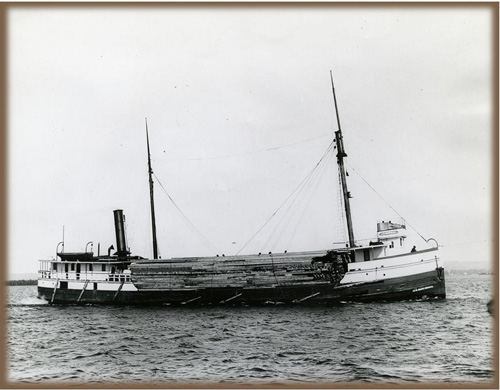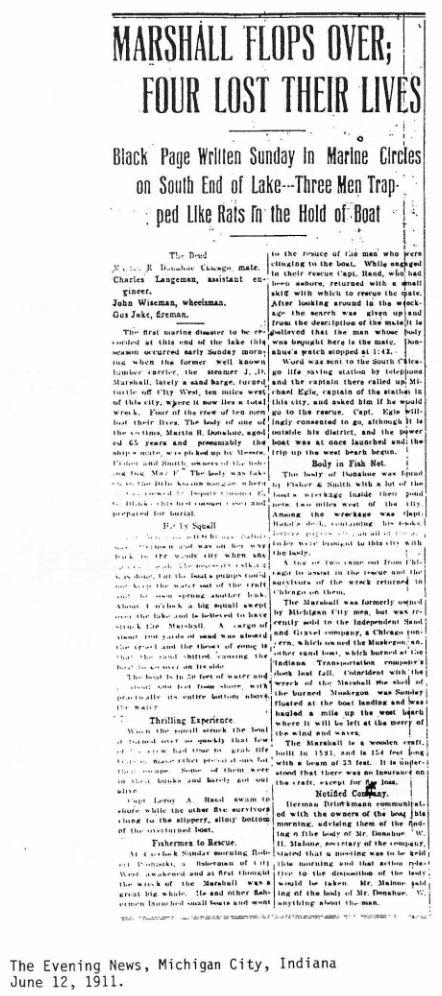The J.D. Marshall was a typical representation of her class of open hulled wooden steamers built during the late 19th century to serve within the growing lumber business. Though not competitive in size to the other Great Lakes steamers, the J.D. Marshall was 154.5’ long with a beam of 33.5’ and a depth of 12’ (Ellis, 1985).
Built in 1891 by J.C. Perene at South Haven, Michigan’s Martel Boatyard, as an open hulled wooden steamer, the J.D. Marshall was initially used in the Great Lakes lumber trade business. Her engines, and possibly boiler assemblies, were constructed at Port Huron, Michigan. The remaining large scotch type boiler was around 7.5’ in depth and 11’10’’ in length. When combined with the still attached condensing unit, the boiler reaches a depth of 13’5’’ (Ellis, 1985).
Immediately following her launch on July 4, 1891, the J.D. Marshall served in the Great Lakes lumber trade under the ownership of the Williams Transport Company, and quickly became heavily involved in commercial traffic efforts. The Marshall has been operated by various owners over her 20 year stretch of service. After her construction, she was likely owned by a J. O. Nessen and Company of Manistee, Michigan, followed by the Independent Sand and Gravel Company in late 1910 or early 1911. The change in ownership was partly due to the insurance settlement over the loss of the Muskegon, which was the company’s only other sand barge that burned at the dock of the Indiana Transportation Company on October 6th, 1910. Following the insurance settlement over the loss of the Muskegon in 1910, and the Independent Sand and Gravel Company’s purchase of the J.D. Marshall, she was refitted for the gravel business with many of the salvaged items from the Muskegon. The Marshall was sent to the Manitowoc Shipyards with various pumps and pieces of equipment salvaged from the Muskegon, with the goal of replacing the burned Muskegon with the Marshall. The Marshall was then stationed in the Chicago West area (i.e., now the Indiana Dunes State Park) (Ellis, 1985).
Despite having been dry docked for repairs just a few months prior to her sinking, it was deemed that the repairs made to the vessel were likely more focused on mechanical refitting, as opposed to structural refitting. Typically, ships of this design would incorporate large wooden, metal, or composite arch trusses into or onto their hull frames in order to prevent hogging caused by the immense weight of the lumber (significantly more structurally stressful than wet sand). The Marshall had some metal strapping added to the frame to prevent too much frame sag, but it became clear after her sinking that her hull was never reinforced with an arch. Aside from the inclusion of steel beams and riveted strapping, the Marshall contained significantly less extensive strapping than what was typically found on other larger vessels. Therefore, on June 9, 1911, the J.D. Marshall sprang a leak and sank, claiming four lives, about 300 yards from shore. Resulting debris from the accident could be seen for miles along the coast, attracting local attention and press for a short period of time (Ellis, 1985).
“The MARSHALL, which during the early spring, had been equipped with the pumps from the burned sandsucker Muskegon and converted into a sandsucker at the Manitowoc shipyards, had been working at Lincoln Park but Saturday came out to city West and there took on about 400 yeards of sand. About 5 o’clock the barge, which was old and not fit to carry lumber, much less sand, sprung a leak, which required several hours to close. The boat lay at anchor with her stern to the shore. Along about 1:45 a squall came up from the west and struck the old sand barge just as she was about ready to make a start for Chicago. Apparently, the barge withstood the storm for ten to fifteen minutes. She commenced leaking very badly again and was soon half full of water. When the storm reached its height, the boat rolled over like a log. This shifted the cargo of sand (and) there was no such thing as the MARSHALL righting herself. She still rests in that position in thirty feet of water and about four feet of her bottom above the water. Her stern is toward the sore and the bow is held by the anchor. She is out three hundred yards from shore.”
(Michigan City Evening Dispatch: December 12, 1911.)
Discovered by Gene Turner, local professional diver in 1979, the J.D. Marshall has had numerous features removed by wreck divers. The wreckage became an incredibly popular sport diving attraction for several years, but eventually some large pieces starting making appearances around the Michigan City area. The illegally recovered deck winch and rudder assembly were donated to the Michigan City Lighthouse Museum. The Dake steam powered deck winch, which may have belonged to the Muskegon, was given to the LaPorte County Steam Show.
In 1982 the entire vessel was raised by salvors intending to remove the Marshall from the sandy bottom, remove her propeller, and distribute the hull and associated wreckage and debris around Michigan, all to eventually re-sink the vessel in shallower water. Parts of the hull were planned to be converted to coffee tables and various souvenirs. The salvors successfully removed the propeller (later confiscated by the State and currently housed in the Dunes State Park), but they were stopped by District 11 Conservation Officers under state law. Therefore, during the raising operation, the vessel was subsequently dropped at its current location in 30-35 feet of water, 3500 feet offshore of Dunes State Park Pavilion and Boat House. This sudden re-sinking of the vessel led to significant damage to the main frame of the hull (Ellis, 1985).
After her dedication on September 30, 2013 at Indiana Dunes State Park, the J.D. Marshall shipwreck site became part of Indiana's first underwater nature preserve. State dedicated nature preserves are granted the greatest level of protection measures within Indiana borders, with the goal of preventing any threats of destruction, damage, or illegal salvage. The J.D. Marshall Nature Preserve is managed by the DNR divisions of Nature Preserves, State Parks & Reservoirs and Law Enforcement.



